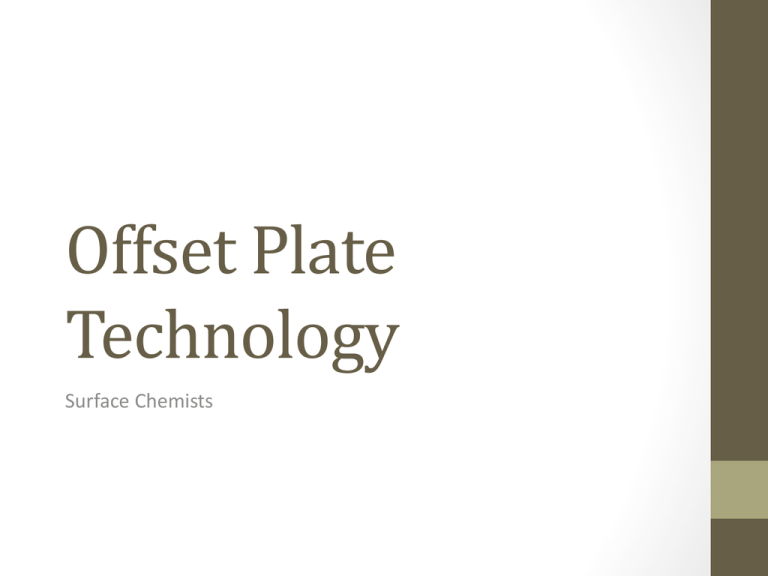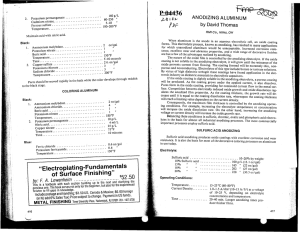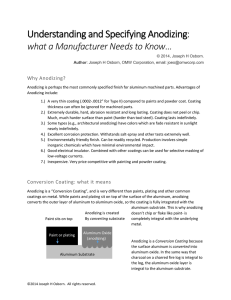Offset Plate Technology
advertisement

Offset Plate Technology Surface Chemists Overview • Offset Plate Production requires multiple steps or phases in the manufacturing process. Material handling and inspection to specific tolerances is critical for successful output. The following components apply: • • • • • • • • Coil Inspection Degrease / Clean coils Graining Anodizing Post Treatment Coating Converting Packaging The Manufacturing Process • Manufactures of offset printing plates “alter the surface of aluminum” to produce products that meet specific requirements for imaging quality and printing performance. • The process requires producing plates from coils of aluminum that are supplied from aluminum mills. Aluminum is supplied in specific mill gauges, holding metallurgical tolerances for tinsel strength, elongation, hardness, flatness, etc…. • Litho sheet is a highly specialized product (represents 1% of the total aluminum industry) that must be devoid of surface imperfections. After the coating process, the material must be void free from the factory to deliver the best quality products. Aluminum Coils Coils of aluminum are mounted to a continuous production process. Cleaning Coils • At the rolling mills an oil lubricant is applied to the coils of aluminum. The first phase in the process of creating an offset plate is to degrease or clean the coils with a cleaning agent like Trisodium Phosphate (TSP). Graining • The grain of the plate acts as the foundation of an offset plate. There are different methods of graining which include mechanical, chemical, electrochemical and a combination of a mechanical/electrochemical process. • Producers increase the surface area of the plate adding “teeth” or “peaks and valleys” to the smooth surface of aluminum. • This permits subsequent chemistries to adhere to the surface and makes the plate more abrasion resistant to stand up to the “hostile printing press”. • Graining helps the plate surface carry water. Micro Photo Grain 300X Micro Photo Grain 1000X Electrochemical Graining Anodizing • Anodizing provides the ability to obtain longer run-lengths or physical impressions from the plate. The following characteristics are improved via anodizing: • • • • A) Abrasion resistance B) Scratch resistance C) Corrosion resistance D) Improves the water carrying or hydrophilic properties of the plate. • Anodizing places a controlled oxide layer in/on the surface of aluminum, which is more uniform and consistent then what exists in nature. In the anodizing process, we essentially strip off the existing oxide layer (provided by nature) and replace it. Anodizing continued…. • Anodizing is like a “hard ceramic porous sponge” sitting in/on the aluminum. In the process, a hot water seal closes the pores trapping the anodic layer in the pores of the aluminum. • Manufactures control the thickness and hardness of the oxide layer by adjusting the concentration of acid (sulfuric acid, phosphoric acid) and amount or electrical energy used in the process. • On a scale from 1-10 with talc being a 1…and 10 being a diamond, the anodic layer is in the range of an 8 similar to the hardness of a Sapphire stone. Anodizing Post Treatments • Post treatments are used after the anodizing process to create a barrier layer between the hydrophilic anodized aluminum and the subsequent coatings applied for imaging. • There are multiple options available to manufactures for the post treatment process including Sodium Silicate, Polyvinyl Phosphonic Acid (PVPA), Phosphate Fluoride and others. • The post treatment process creates a photo glue, allowing analog and digital coatings to adhere to the surface of the plate for imaging. Monitoring the process • During the manufacturing process, automated systems are in place to monitor tank concentrations, temperature, line speed, electrical current, etc., while surface topography and coatings are inspected utilizing video and laser inspection systems. Coatings • Plate manufactures apply specifically tuned coatings to the plate for the creation of plate products. • The spectral sensitivity of plates are designed to be receptive to specific wave-lengths. • Analog plates = 360-380nm • Violet CTP plates = 405nm • Thermal CTP plates – 830nm • The process involves applying specific coat weights and must be very tightly controlled and monitored. The amount of energy required for imaging is directly related to the speed and sensitivity of the coatings being applied. Coating line Converting • All suppliers of plate products convert coils of coated product into sheet form to meet your pressroom requirements. Plates are converted holding specific tolerances for length, width, burr, flatness and squareness. • Every package of printing plates includes a package ID number or in some cases a bar code that correlates to the internal manufacturing records of the supplier. • Packaging specifications are supplier specific, but for the most part the delivery of plates to the end user is pretty straight forward. Converting Questions? J. Faulkner National Accounts Manager Anocoil Corporation







